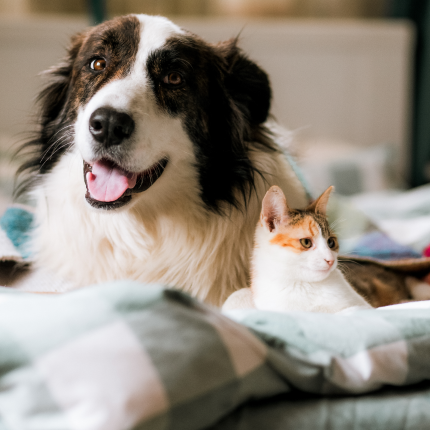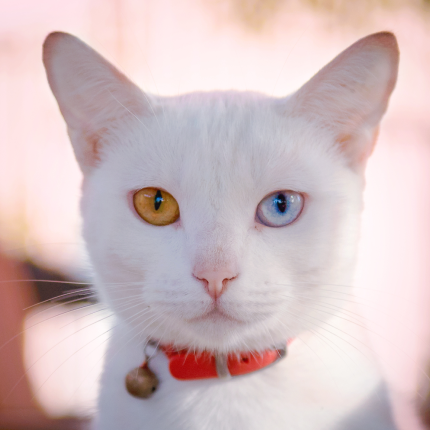How to Introduce Cats and Dogs The Right Way

Many dogs can coexist peacefully with cats, often forming close bonds that allow them to sleep together and groom one another. However, not all dogs and cats can live in harmony. Some cats may feel anxious around dogs; even a calm dog can unintentionally scare a cat. Plus, certain dogs have a strong predatory drive, making it unsafe to be left alone with cats.
If a dog consistently shows signs of excitement around cats and struggles to calm down, it may not be safe for the two to share a home. In such cases, it is advisable to keep them apart and seek guidance from a qualified behaviorist.
Preparing for a Meeting
When introducing a new cat or dog into a household, make the introductions gradual and controlled. Here are several tips to consider before bringing the animals together:
Scent Swapping
Scent is an important form of communication for both dogs and cats. Before introducing the new pet, it helps to familiarize each animal with the other’s scent.
- Request a blanket or toy that carries the new pet’s scent and place it in a shared area for your resident pet to investigate at their own pace.
- It also helps to provide the new pet’s current caregiver with an item that smells like the existing pet.
- For the first week after bringing the new pet home, continue to exchange bedding items. Do this until both pets show no signs of distress toward each other’s scents.
Create Individual Areas
Establish designated spaces for each pet to eat, drink, rest, and relieve themselves securely. Ensure that both animals can access their resources without encountering one another.
Physical Barriers
Physical barriers, such as baby gates or closed doors, can help keep the pets separated during the initial introductions. Cats should never be forced into the same room as dogs and should have escape routes available if they feel threatened.
Maintaining Separation
Cats and dogs should remain separate unless supervised by a responsible adult who can reward positive behavior. Even during supervised interactions, physical barriers should be used. Keeping the dog on a leash or a house-training line can help ensure a calm introduction.
Respecting the Cat’s Pace
The introduction process should be tailored to the cat’s comfort level, as cats are generally smaller and more vulnerable. They should always have the option to move away if needed. Never force a cat into a situation with a dog. If the cat chooses to approach, the dog’s behavior must be controlled, and the dog should be rewarded for remaining calm.
Over time, with proper guidance, the dog should learn to focus on its owner in the cat’s presence while the cat builds confidence around the dog. If the dog displays excitement or tries to chase the cat, it is best to remove the dog from the situation. Gradually increase their exposure to one another. If the cat exhibits aggressive behavior towards the dog, even if the dog is calm, keep them separated and consult a behaviorist.
Keeping the Peace
Once a successful introduction has taken place, there are additional steps that can be taken to ensure both pets are happy and coexist peacefully:
- Maintain a designated area where the cat can eat, sleep, play, and use the litter box without coming into contact with the dog.
- Provide vertical spaces, such as shelves or ledges. This allows the cat to navigate without interacting with the dog at ground level.
- Always reward the dog for calm behavior around the cat. Avoid scolding the dog for inappropriate actions, as this could create confusion and negative associations with the cat.
- If the dog cannot be trusted around the cat, keep them separate or use a leash to prevent chasing. Continue to train the dog for calm interactions and seek advice if necessary.
A well-exercised dog is often calmer around a cat, so ensuring that the dog receives adequate mental and physical stimulation is critical to maintaining harmony in a multi-pet household.

Featured Articles

Greebles and Cats: The Origin and the Meaning
You may have seen an internet sensation concerning cats labeled “greebles.” Feel out of the loop? We’re here to help you. In 2019, Reddit user /user/literallyatree commented on a Reddit post about a cat that looks like it’s trying to slap a ghost. This user commented: “My family calls things…

Why Do Cats Roll Over Into Their Backs But Not Let You Touch Their Bellies?
It’s common knowledge dogs love to have their tummies rubbed when they freely lay down before you and roll onto their backs. But, if you’re also familiar with cats, you know that when they roll onto their backs with their bellies exposed, rubbing the belly will most likely result in…

The Odd-Eyed Cat (AKA Heterochromia)
Cats are already beautiful and fascinating creatures, but people are bound to take notice when they have something as captivating as two different colored eyes. Odd-eyed cats always have one blue eye paired with either a green, yellow, or brown eye. This form of heterochromia occurs in other animals, including…
